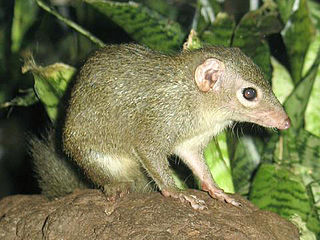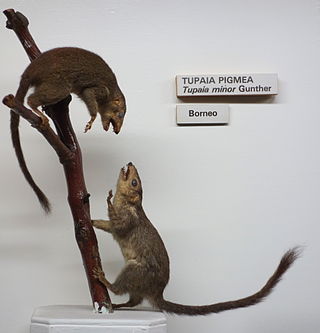
The common treeshrew is a small mammal in the treeshrew family Tupaiidae, and is native to Thailand, Malaysia, and Indonesia. It has been listed as Least Concern by IUCN as it remains common and displays some adaptability to ongoing habitat loss.

Allen's yellow bat is a species of vesper bat. There is some taxonomic debate surrounding this species, with some authors considering Baeodon a genus rather than a subgenus. It is endemic to Mexico.

The striped treeshrew is a treeshrew species within the Tupaiidae. It is endemic to Borneo and known only from a few individuals in Sabah, Sarawak, Brunei and Kalimantan.

The slender treeshrew is a treeshrew species within the Tupaiidae. It is native to Borneo and inhabits foremost lowland old forest.

The long-footed treeshrew is a treeshrew species within the Tupaiidae. It is endemic to Borneo and threatened due to deforestation and degradation of habitat.

The pygmy treeshrew is a treeshrew species within the family Tupaiidae. It is native to Thailand, Malaysia and Indonesia. The generic name is derived from the Malay word tupai meaning squirrel or small animals that resemble squirrels.

The mountain treeshrew is a treeshrew species within the Tupaiidae. It is endemic to Borneo and inhabits montane forests in Sarawak and Sabah, Malaysia, and Kalimantan, Indonesia.

The Nicobar treeshrew is a treeshrew species within the Tupaiidae. It is endemic to the Nicobar Islands where it inhabits the islands' rain forests. It is threatened by habitat loss.

The ruddy treeshrew is a treeshrew species in the family Tupaiidae. It is endemic to Borneo, the Natuna Islands and the Anambas Islands.

The large treeshrew is a treeshrew species within the Tupaiidae. It is native to Sumatra and adjacent small islands, as well as in the lowlands and hills of Borneo.

The Mindanao treeshrew, also called the Philippine tree shrew, is a species of treeshrew endemic to the Mindanao region in the Philippines. It was formerly considered the only member of the genus Urogale, but that genus was merged into Tupaia when the species was found to nest within the latter genus in a molecular phylogeny. The scientific name commemorates British colonial administrator and zoological collector Alfred Hart Everett.

Tupaia is a treeshrew genus in the family Tupaiidae that was first described by Thomas Stamford Raffles in 1821. The name of this genus derives from the Malay word tupai meaning squirrel or small animal resembling a squirrel.

Tupaiidae is one of two families of treeshrews, the other family being Ptilocercidae. The family contains three living genera and 19 living species. The family name derives from tupai, the Malay word for treeshrew and also for squirrel which tupaiids superficially resemble. The former genus Urogale was disbanded in 2011 when the Mindanao treeshrew was moved to Tupaia based on a molecular phylogeny.
The Bangka Island treeshrew, also known as the Bangkan treeshrew, is a treeshrew species within the Tupaiidae. It was previously listed as a junior synonym to Tupaia glis, but was raised up to species status in 2013. It is only found on Bangka Island, which is off the coast of Sumatra.
The Sumatran treeshrew is a treeshrew species within the Tupaiidae family. It was previously listed as a subspecies of Tupaia glis for one hundred years, but was raised up to species status in 2013. It is found on the islands of Sumatra and Tanahbala in Indonesia. It is the type species for the Tupaia genus.
The Kalimantan treeshrew or southern large-footed treeshrew is a treeshrew species within the Tupaiidae family. It was originally described as a subspecies of Tupaia longipes and later listed as a junior synonym of Tupaia glis, before being returned to its subspecies status. It was raised up to species status in 2013. It is found on southern portion of the island of Borneo in Indonesia.














